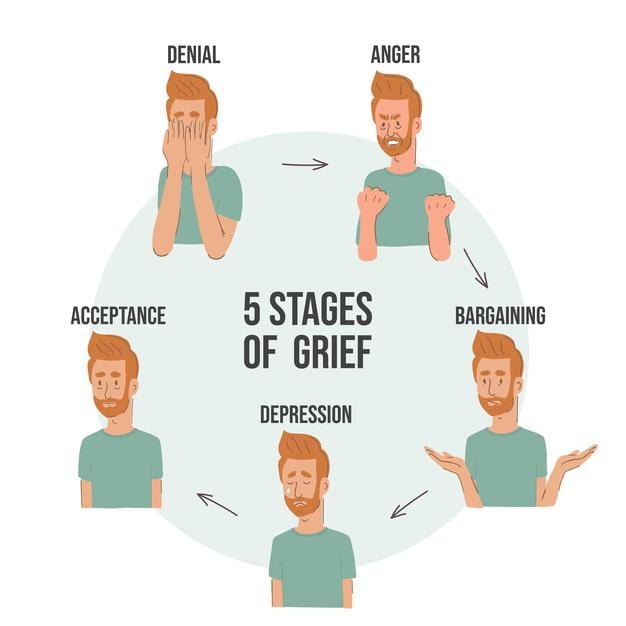Grieving a Divorce - No Stages, Just Themes: Part I
In grief, whether it’s a common loss (the death of a loved one) or an ambiguous/living loss (such as a divorce), many will refer to the stages of grief; believing the only way to navigate a grief journey is through experiencing and overcoming each stage. For those who are grieving a divorce, you may carry the thought of “what are the stages of grieving a divorce?” I’m here to tell you, there are no stages in grief, including grieving a divorce; rather themes you may experience.
I will break this blog into two parts; the first part will provide understanding as to why stages are frequently paired with grief and why grief counselors steer those who are grieving away from the stages. The second part (coming next month) will label and discuss some of the themes that can be experienced when grieving a divorce.
Why Do We Pair Stages With Grief?
If you’re not familiar with the 5 stages of grief I’m referring to, they are:
Denial
Anger
Bargaining
Depression
Acceptance
These stages that are so commonly applied to a grief process stem from the work of Dr. Elizabeth Kubler-Ross. She originally created the 5 stages above for those who were in the dying process. It became such a well known (and tangible) structure, that it was quickly attached to the grieving process; allowing people to make sense of a process that holds a lot of ambiguity, lack of direction and uncertainty.
When you think of “doing the grief work”, what comes to mind? Often times, that question is often met with “I don’t know what grief is supposed to look like.” Grief itself is already a tough process, then to not have structure or an idea of how to effectively navigate the process on top of that can leave people resisting the work. This is the main reason people tend to gravitate towards the stages when walking through the grief process. It gives them structure; a “road map” to follow which, in turn, provides them with comfort and willingness to walk through the tough journey of grief. Knowing this, you may be wondering “why would grief counselors/therapists steer people away from the stages?” Let’s talk about it!
Grieving a Divorce: 4 Reasons For Steering Away From The Stages
There are many reasons I steer clients away from the 5 stages however, these are the ones I discuss most often (and seem to resonate the most) with clients:
Am I Doing It Wrong? While the stages can provide a structure, it can often leave people wondering if they’re doing something wrong when/if they don’t hit all 5 stages or they happen out of order.
Grief Is Unique: just like humans, every grief journey is unique. Are there similarities? Absolutely! However, even within the similarities, each similarity takes its own shape. If grief follows something like stages, it creates a mold that doesn’t allow for uniqueness; another factor that can leave individuals wondering if they’re doing the grief process incorrectly or “is something wrong with me?”.
There’s No Timeline In Grief: clients will frequently ask me “Am I going to feel this way forever?” The answer is yes and no; grief never goes away however the intensity and frequency changes over time. If we are following stages, it implies once we’ve hit all stages (which we know from above, some may not experience all 5), our process is complete. Grief isn’t measure by time.
Grief Is Not Linear: take a look at the image to the right. This is the expectation of grief vs. the reality of grief. Stages imply we not only hit all stages but we do so in chronological order/linear fashion. Grief can go in all sorts of directions; up, down, back, forward, sideways…it’s part of its uniqueness. This can be liberating and/or frustrating.
If Not Stages of Grieving a Divorce, Then What?
You may find yourself wondering, “okay, if therapists steer away from the stages, then how do they effectively guide someone though the process of grieving a divorce?” GREAT question! While grief is unique to each person, we’ve discovered themes within any grief journey (whether common loss or ambiguous loss) that can be used as a starting point while still allowing individuals to walk grief in a fashion that makes sense to them.
Next month’s blog article will discuss these themes so stay tuned for part II! Until then, I encourage you to explore the following questions:
How can you begin to release yourself from the expectations and rigidity of the stages of grief?
How does the idea of not having stages to follow feel for you?
Are you able to begin redefining your grief journey if not following the stages?
Regardless of how you (and IF you’re able to ) answer these above questions, remember the only “right” way to grieve is doing it in a fashion that fits and feels true for you.
Here’s to living a a better life as your best self.
Brittany Squillace, MA, LMFT
Licensed Marriage & Family Therapist



